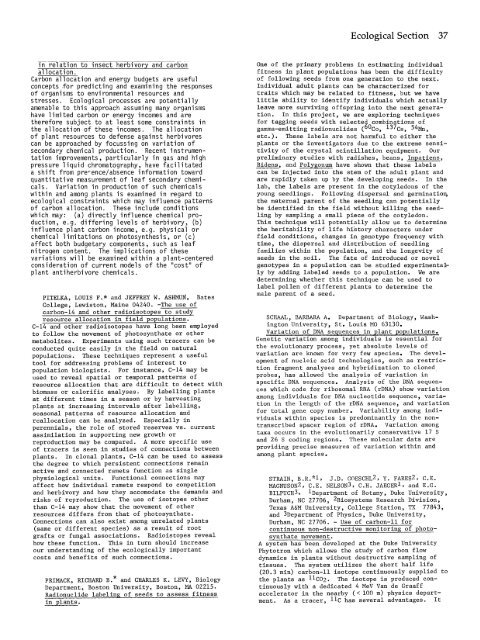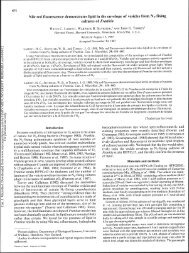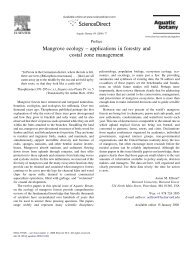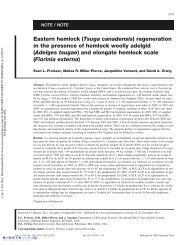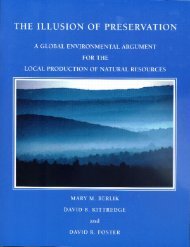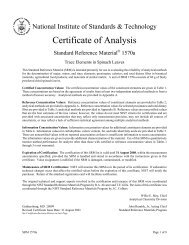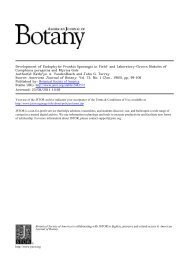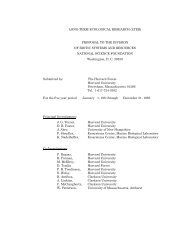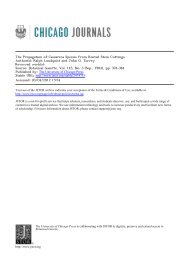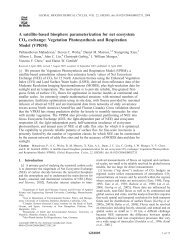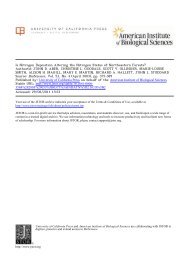Abstracts of Papers - Harvard Forest - Harvard University
Abstracts of Papers - Harvard Forest - Harvard University
Abstracts of Papers - Harvard Forest - Harvard University
Create successful ePaper yourself
Turn your PDF publications into a flip-book with our unique Google optimized e-Paper software.
in relation to insect herbivory and carbon-<br />
allocation.<br />
Carbon allocation and energy budgets are useful<br />
concepts *for predicting and examining the responses<br />
<strong>of</strong> organisms to environmental resources and<br />
stresses. Ecological processes are potentially<br />
amenable to this approach assuming many organisms<br />
have limited carbon or energy incomes and are<br />
therefore subject to at least some constraints in<br />
the allocation <strong>of</strong> these incomes. The allocation<br />
<strong>of</strong> plant resources to defense against herbivores<br />
can be approached by focussing on variation <strong>of</strong><br />
secondary chemical production. Recent instrumen-<br />
tation improvements, particularly in gas and high<br />
pressure liquid chromatography, have facilitated<br />
a shift from pre,ence/absence information toward<br />
quantitative measurement <strong>of</strong> leaf secondary chemi-<br />
cals. Variation in production <strong>of</strong> such chemicals<br />
within and among plants is examined in regard to<br />
ecological constraints which may influence patterns<br />
<strong>of</strong> carbon allocation. These include conditions<br />
which may: (a) directly influence chemical pro-<br />
duction, e.g. differing levels <strong>of</strong> herbivory, (b)<br />
influence plant carbon income, e.g. physical or<br />
chemical limitations on photosynthesis, or (c)<br />
affect both budgetary components, such as leaf<br />
nitrogen content. The implications <strong>of</strong> these<br />
variations will be examined within a plant-centered<br />
consideration <strong>of</strong> current models <strong>of</strong> the "cost" <strong>of</strong><br />
plant antiherbivore chemicals.<br />
PITELKA, LOUIS F.* and JEFFREY W. ASHMUN, Bates<br />
College, Lewiston, Maine 04240. -The use <strong>of</strong><br />
carbon-14 and other radioisotopes to study<br />
resource allocation in field populations.<br />
C-14 and other radioisotopes have long been employed<br />
to follow the movement <strong>of</strong> photosynthate or other<br />
metabolites. Experiments using such tracers can be<br />
conducted quite easily in the field on natural<br />
populations. These techniques represent a useful<br />
tool for addressing problems <strong>of</strong> interest to<br />
population biologists. For instance, C-14 may be<br />
used to reveal spatial or temporal patterns <strong>of</strong><br />
resource allocation that are difficult to detect with<br />
biomass or calorific analyses. By labelling plants<br />
at different times in a season or by harvesting<br />
plants at increasing intervals after labelling,<br />
seasonal patterns <strong>of</strong> resource allocation and<br />
reallocation can be analyzed. Especially in<br />
perennials, the role <strong>of</strong> stored reserves vs. current<br />
assimilation in supporting new growth or<br />
reproduction may be compared. A more specific use<br />
<strong>of</strong> tracers is seen in studies <strong>of</strong> connections between<br />
plants. In clonal plants, C-14 can be used to assess<br />
the degree to which persistent connections remain<br />
active and connected ramets function as single<br />
physiological units. Functional connections may<br />
affect how individual ramets respond to competition<br />
and herbivory and how they accomodate the demands and<br />
risks <strong>of</strong> reproduction. The use <strong>of</strong> isotopes other<br />
than C-14 may show that the movement <strong>of</strong> other<br />
resources differs from that <strong>of</strong> photosynthate.<br />
Connections can also exist among unrelated plants<br />
(same or different species) as a result <strong>of</strong> root<br />
grafts or fungal associations. Radioistopes reveal<br />
how these function. This in turn should increase<br />
our understanding <strong>of</strong> the ecologically important<br />
costs and benefits <strong>of</strong> such connections.<br />
PRIMACK, RICHARD B. * and CHARLES K. LEVY, Biology<br />
Department, Boston <strong>University</strong>, Boston, MA 02215.<br />
Radionuclide labeling <strong>of</strong> seeds to assess fitness<br />
in plants.<br />
Ecological Section 37<br />
One <strong>of</strong> the primaty problems in estimating individual<br />
fitness in plant populations has been the difficulty<br />
<strong>of</strong> following seeds from one generation to the next.<br />
Individual adult plants can be characterized for<br />
traits which may be related to fitness, but we have<br />
little ability to identify individuals which actually<br />
leave more surviving <strong>of</strong>fspring into the next genera-<br />
tion. In this project, we are exploring techniques<br />
for tagging seeds with selected combinations <strong>of</strong><br />
gamma-emitting radionuclides (60Co, 137Cs, 54Mn,<br />
etc.). These labels are not harmful to either the<br />
plants or the investigators due to the extreme sensi-<br />
tivity <strong>of</strong> the crystal scintillation equipment. Our<br />
preliminary studies with radishes, beans, Impatiens,<br />
Bidens, and Polygonum have shown that these labels<br />
can be injected into the stem <strong>of</strong> the adult plant and<br />
are rapidly taken up by the developing seeds. In the<br />
lab, the labels are present in the cotyledons <strong>of</strong> the<br />
young seedlings. Following dispersal and germinatiorn<br />
the maternal parent <strong>of</strong> the seedling can potentially<br />
be identified in the field without killing the seed-<br />
ling by sampling a small piece <strong>of</strong> the cotyledon.<br />
This technique will potentially allow us to determine<br />
the heritability <strong>of</strong> life history characters under<br />
field conditions, changes in genotype frequency with<br />
time, the dispersal and distribution <strong>of</strong> seedling<br />
families within the population, and the longevity <strong>of</strong><br />
seeds in the soil. The fate <strong>of</strong> introduced or novel<br />
genotypes in a population can be studied experimental-<br />
ly by adding labeled seeds to a population. We are<br />
determining whether this technique can be used to<br />
label pollen <strong>of</strong> different plants to determine the<br />
male parent <strong>of</strong> a seed.<br />
SCHAAL, BARBARA A. Department <strong>of</strong> Biology, Washington<br />
<strong>University</strong>, St. Louis MO 63130.<br />
Variation <strong>of</strong> DNA seguences in plant populations.<br />
Genetic variation among individuals is essential for<br />
the evolutionary process, yet absolute levels <strong>of</strong><br />
variation are known for very few species. The development<br />
<strong>of</strong> nucleic acid technologies, such as restriction<br />
fragment analyses and hybridization to cloned<br />
probes, has allowed the analysis <strong>of</strong> variation in<br />
specific DNA sequences. Analysis <strong>of</strong> the DNA sequences<br />
which code for ribosomal RNA (rDNA) show variation<br />
among individuals for DNA nucleotide sequence, variation<br />
in the length <strong>of</strong> the rDNA sequence, and variation<br />
for total gene copy number. Variability<br />
viduals within species is predominantly<br />
among indiin<br />
the nontranscribed<br />
spacer region <strong>of</strong> rDNA. Variation among<br />
taxa occurs in the evolutionarily conservative 17 S<br />
and 26 S coding regions. These molecular data are<br />
providing precise measures <strong>of</strong> variation within and<br />
among plant species.<br />
STRAIN, B.R.*l, J.D. GOESCHL2, Y. FARES?-2 C.E.<br />
MAGNUSON2, C.E. NELSON3, C.H. JAEGER1, and E.G.<br />
BILPUCH3. lDepartment <strong>of</strong> Botany, Duke <strong>University</strong>,<br />
Durham, NC 27706, 2Biosystems Research Division,<br />
Texas A&M <strong>University</strong>, College Station, TX 77843,<br />
and 3Department <strong>of</strong> Physics, Duke <strong>University</strong>,<br />
Durham, NC 27706. - Use <strong>of</strong> carbon-li for<br />
continuous non-destructive monitoring <strong>of</strong> photosynthate<br />
movement.<br />
A system has been developed at the Duke <strong>University</strong><br />
Phytotron which allows the study <strong>of</strong> carbon flow<br />
dynamics in plants without destructive sampling <strong>of</strong><br />
tissues. The system utilizes the short half life<br />
(20.3 min) carbon-ll isotope continuously supplied to<br />
the plants as 11CO2. The isotope is produced continuously<br />
with a dedicated 4 MeV Van de Graaff<br />
accelerator in the nearby ( < 100) m) physics department..<br />
As a tracer, hGc has several advantages. lIt


